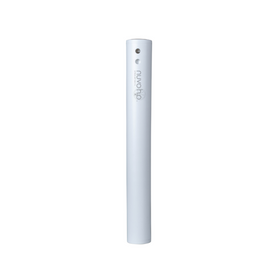
7 Ecological Benefits of Incorporating a Pond in your Yard
Last Updated: Mar 19, 2025A pond is often something you expect to find hidden in a clearing in the woods or veiled by deep grass and shrubs in the middle of a prairie. Throughout history, these small bodies of water have offered moments of inspiration and serenity. Henry David Thoreau, perhaps America’s best-known environmental writer, built a small cabin on the shores of Walden Pond where he wrote his seminal work called “Walden.” In his book, Thoreau describes a pond as “a field of water betrays the spirit that is in the air. It is continually receiving new life and motion from above. It is intermediate between land and sky.”
While most homeowners probably think that ponds belong in the depths of nature, incorporating a small body of water to act as an “intermediate between land and sky” comes with several ecological benefits for the landscape around your house. Below, we look at a few of the most important benefits of integrating ponds into your yard.
7 Benefits of Building a Pond
1. Less grass to water, fertilize and mow
First and foremost, incorporating a pond into the landscape around your home will mean that you will have less grass to mow. Over 40 million acres of turfgrass are planted around our North American homes, and Yale University estimates that Americans collectively use upwards of 600 million gallons of gasoline each year to mow and trim their lawns. Considering that each gallon of gasoline, when burned, releases around 20 pounds of carbon dioxide into the air, our landscaping practices are easily responsible for 12 billion pounds of CO2 being released into the air each year. Not mowing, fertilizing, or watering your grass will save you time and reduce your water bill.
2. Carbon sequestration
Ponds have the ability to act as a carbon sink, meaning that they can capture carbon dioxide in the atmosphere and store that carbon in the biodiversity of both land and aquatic plants that thrive in the pond ecosystem. Dedicating even a small part of your land to a pond, then, can drastically reduce your household carbon footprint by cutting back on the greenhouse gas emissions associated with burning gasoline while sucking up (called “sequestering”) CO2 in the atmosphere.
3. Biodiversity
Ponds are widely regarded as ecological hotspots for diversity. Even a small, artificial pond has been shown to drastically increase the presence and diversity of dragonflies and other beneficial insects. The “edge” effect, or the area where two different ecosystems meet, is known to increase diversity significantly. The edges of the ponds we build are thus important areas for a diversity of plants and wildlife. Frogs and other amphibians will be quick to take up residence in your small pond and will serenade your home with a nightly chorus of natural sounds.
Table of Contents
- Pond Design Considerations
- How to Build a Pond

4. Energy efficiency
A pond ecosystem located in your yard can offer energy efficiency benefits for your home. The water that evaporates from the pond's surface will reduce heat, thus producing a sort of natural, outdoor air conditioning service. Locating a small body of pond next to an outdoor living area adjacent to your house will allow you and your family to spend more time outdoors comfortably, thus reducing the need for running the air conditioner throughout the hot summer days.
5. Greywater potential
Ponds can act as an essential part of an integrated water management system. Whereas most homeowners send the water from their homes into a septic tank or the municipal sewer system, a pond can be a part of a beautiful greywater recycling system. The water from your sinks and showers can be filtered through built wetlands planted with filtering plants such as reeds, cattails, and calla lilies before emptying into your pond.
6. Irrigation potential
The water from your roof and gutter system, instead of ending up as stormwater runoff that contaminates local watersheds and puts stress on municipal sewer systems, can be sent to your pond, creating a reservoir of fresh water that can later be used for outdoor irrigating purposes.
7. Erosion reduction
When strategically positioned in the landscape, a pond can be a part of an erosion reduction strategy to increase the ecological resiliency of your yard.
Pond Design Considerations
If you are ready to integrate an aesthetically pleasing and environmentally beneficial pond into your yard, several design criteria need to be considered.
- Depth: When considering the ideal depth for your pond, you need to think about the purpose of the pond, who will be inhabiting it, and the climate you live in. If, for example, you have young children in the household or neighborhood, keeping the pond relatively shallow is a necessary safety precaution. In addition, if you plan to stock the pond with Koi or other large fish, you will need a depth of at least 3 feet. This is especially important in areas with cold winters to keep the pond from entirely freezing over. For larger ponds in rural settings, depths of 5 feet or more will maximize the carbon-capturing possibilities of ponds.
- Pond liners: For small ponds, a lining will be necessary to prevent water loss during dry times. If you live in an area with limited amounts of rainfall and sandy soil, a pond liner will make it easier to prevent your pond from drying up.
- Pumps: While pumps require energy to run throughout the day, a pump offers several benefits for small ponds, including discouraging algae growth, keeping water fresh and oxygenated, and allowing homeowners to incorporate small waterfalls. On the other hand, larger ponds should be able to develop the necessary ecological balance to discourage algae growth and stay naturally oxygenated.
- Shape: While a small circular or oval-shaped pond is the most customary, incorporating odd shapes offers several benefits. Increasing the amount of “edge” between water and land ecosystems will dramatically increase animal life and diversity around your pond with a habitat for amphibians, insects, birds, and other important species.

2. Once you have the basic shape of the pond, it is time to start digging. Incorporating different levels into your pond (like stair steps) can increase the diversity of aquatic life. For example, an area only about one foot deep is a great place to plant beautiful aquatic plants and reeds. Deeper areas can harbor fish life and help to capture carbon from the atmosphere. The topsoil that is excavated can be used for building a raised-bed garden system.

3. When you are done digging, make sure that there aren’t any sharp rocks or protruding roots that can rip the liner you are ready to install. Lay at least two inches of river sand and an underlayment first. To properly size the liner, you will need to add twice the depth to the length and width of the pond. Add at least two feet to these numbers, and you can then cut your pond liner. Low-density polyethylene liners are usually the best combination of performance and price for small, residential ponds. Once your liner is laid, you can begin the process of filling out your pond. A layer of rocks around the outside of the pond is a great option to hold down your liner, while water-loving plants can be planted around the edge of the pond.
Tobias Roberts
Tobias runs an agroecology farm and a natural building collective in the mountains of El Salvador. He specializes in earthen construction methods and uses permaculture design methods to integrate structures into the sustainability of the landscape.












